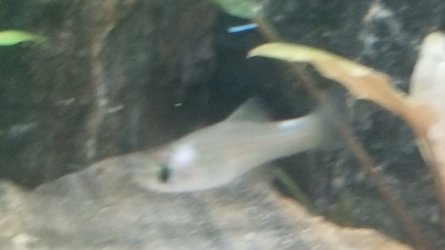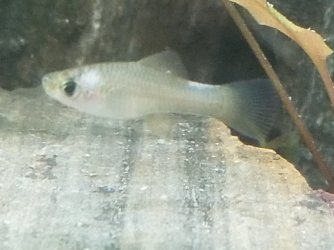Request Help
Tank size: 45 Gallons
pH: 6.8-7
ammonia: 0 - .25
nitrite: 0 - .25
nitrate: 5.0
kH: My kit and local shop does not test this.
gH: My kit and local shop does not test this
tank temp: 81
Fish Symptoms (include full description including lesion, color, location, fish behavior):
Looks whitish blue. Headish area and tail. See picture below. I believe she is female as she is lacking the tail of Male swords are starting to develop. She is eating. Swimming and acting fairly normal as she did in the fry tank and when she was moved to the 45. She is a kallmani swordtail. She is remaining with her school or the raspbora.
Volume and Frequency of water changes: As tank is cycled I do 25% once a week with water checks twice a week. And time I do plant work it also gets a 25% water change atop of the planned one.
Chemical Additives or Media in your tank: we use fluval clearmax
Tank inhabitants: 2 pearl gourami, 4 harlequin raspbora, 3 orange Venezuelans cory, 2 thai flying fox, 2 blue Japanese double swordtails, 6 serpae long fin tetra and 6 xiphophorus kallmani swordtails.
Recent additions to your tank (living or decoration): Plants were moved from quarantine to main tank earlier this week.
Exposure to chemicals: All chemicals used are seachem brand. Flourish was used earlier this week when the new plants were added. The plants had been treated using the bleach method but had been cleaned and spent over a 2 week period in QT. It was also treated with the suggested amount of prime twice to dealing with such chemicals before being allowed to sit.
Other info: The fry are about 3-4 weeks old. I am fairly new to keeping tanks this size and this was my first aquascape so it's very possible I just messed up. I just dont want her to suffer but dont want to over medicate. I also wonder if it's her "color" coming in as I've never had fry before.
Digital photo (include if possible):
Tank size: 45 Gallons
pH: 6.8-7
ammonia: 0 - .25
nitrite: 0 - .25
nitrate: 5.0
kH: My kit and local shop does not test this.
gH: My kit and local shop does not test this
tank temp: 81
Fish Symptoms (include full description including lesion, color, location, fish behavior):
Looks whitish blue. Headish area and tail. See picture below. I believe she is female as she is lacking the tail of Male swords are starting to develop. She is eating. Swimming and acting fairly normal as she did in the fry tank and when she was moved to the 45. She is a kallmani swordtail. She is remaining with her school or the raspbora.
Volume and Frequency of water changes: As tank is cycled I do 25% once a week with water checks twice a week. And time I do plant work it also gets a 25% water change atop of the planned one.
Chemical Additives or Media in your tank: we use fluval clearmax
Tank inhabitants: 2 pearl gourami, 4 harlequin raspbora, 3 orange Venezuelans cory, 2 thai flying fox, 2 blue Japanese double swordtails, 6 serpae long fin tetra and 6 xiphophorus kallmani swordtails.
Recent additions to your tank (living or decoration): Plants were moved from quarantine to main tank earlier this week.
Exposure to chemicals: All chemicals used are seachem brand. Flourish was used earlier this week when the new plants were added. The plants had been treated using the bleach method but had been cleaned and spent over a 2 week period in QT. It was also treated with the suggested amount of prime twice to dealing with such chemicals before being allowed to sit.
Other info: The fry are about 3-4 weeks old. I am fairly new to keeping tanks this size and this was my first aquascape so it's very possible I just messed up. I just dont want her to suffer but dont want to over medicate. I also wonder if it's her "color" coming in as I've never had fry before.
Digital photo (include if possible):



